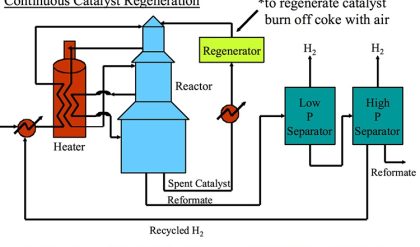
Petroleum coke, abbreviated coke or petcoke, is a final carbon-rich solid material that derives from oil refining, and is one type of the group of fuels referred to as cokes. Petcoke is the coke that, in particular, derives from a final cracking process—a thermo-based chemical engineering process that splits long chain hydrocarbons of petroleum into shorter chains—that takes place in units termed coker units.[1] (Other types of coke are derived from coal.) Stated succinctly, coke is the “carbonization product of high-boiling hydrocarbon fractions obtained in petroleum processing (heavy residues).”[1] Petcoke is also produced in the production of synthetic crude oil (syncrude) from bitumen extracted from Canada’s oil sands and from Venezuela’s Orinoco oil sands.[2][3]
In petroleum coker units, residual oils from other distillation processes used in petroleum refining are treated at a high temperature and pressure leaving the petcoke after driving off gases and volatiles, and separating off remaining light and heavy oils. These processes are termed “coking processes”, and most typically employ chemical engineering plant operations for the specific process of delayed coking.

A delayed coking unit.A schematic flow diagram of such a unit, where residual oil enters the process at the lower left (see →), proceeds via pumps to the main fractionator (tall column at right), the residue of which, shown in green, is pumped via a furnace into the coke drums (two columns left and center) where the final carbonization takes place, at high temperature and pressure, in the presence of steam.
This coke can either be fuel grade (high in sulfur and metals) or anode grade (low in sulfur and metals). The raw coke directly out of the coker is often referred to as green coke.[1] In this context, “green” means unprocessed. The further processing of green coke by calcining in a rotary kiln removes residual volatile hydrocarbons from the coke. The calcined petroleum coke can be further processed in an anode baking oven to produce anode coke of the desired shape and physical properties. The anodes are mainly used in the aluminium and steel industry.
Petcoke is over 80% carbon and emits 5% to 10% more carbon dioxide (CO2) than coal on a per-unit-of-energy basis when it is burned. As petcoke has a higher energy content, petcoke emits between 30 and 80 percent more CO2 than coal per unit of weight.[3] The difference between coal and coke in CO2 production per unit of energy produced depends upon the moisture in the coal, which increases the CO2 per unit of energy – heat of combustion – and on the volatile hydrocarbons in coal and coke, which decrease the CO2 per unit of energy.
Types
There are at least four basic types of petroleum coke, namely, needle coke, honeycomb coke, sponge coke and shot coke. Different types of petroleum coke have different microstructures due to differences in operating variables and nature of feedstock. Significant differences are also to be observed in the properties of the different types of coke, particularly ash and volatile matter contents.
Needle coke, also called acicular coke, is a highly crystalline petroleum coke used in the production of electrodes for the steel and aluminium industries and is particularly valuable because the electrodes must be replaced regularly. Needle coke is produced exclusively from either fluid catalytic cracking (FCC) decant oil or coal tar pitch.
Honeycomb coke is an intermediate coke, with ellipsoidal pores that are uniformly distributed. Compared to needle coke, honeycomb coke has a lower coefficient of thermal expansion and a lower electrical conductivity.
Composition
Petcoke, altered through the process of calcined which it is heated or refined raw coke eliminates much of the component of the resource. Usually petcoke when refined does not release the heavy metals as volatiles or emissions.
Depending on the petroleum feed stock used, the composition of petcoke may vary but the main thing is that it is primarily carbon.Petcoke is primarily made up of carbon, when in pure form petcoke can weigh 98-99% which creates a carbon based compound with the hydrogen filling in. In raw form hydrogen can have a weight range of 3.0- 4.0%. Petcoke in its raw(green coke) nitrogen at 0.1- 0.5% and sulfur 0.2- 6.0% become emissions after the coke calcined.
| Composition of raw petcoke | |
| Component | Raw (green) coke |
| Carbon (wt%) | 80-95 |
| Hydrogen (wt%) | 3.0-4.5 |
| Nitrogen (wt%) | 0.1- 0.5 |
| Sulfur (wt%) | 0.2-6.0 |
| Volatile matter (wt%) | 5.0-15 |
| Moisture (wt%) | 0.5-10 |
| Ash (wt%) | 0.1- 1.0 |
| Density (wt%) | 1.2- 1.6 |
| Heavy Metals (ppm. wt) | |
| Aluminium | 15-100 |
| Boron | 0.1- 15 |
| Calcium | 25- 500 |
| Chromium | 5-50 |
| Cobalt | 10-60 |
| Iron | 50-5000 |
| Manganese | 2-100 |
| Magnesium | 10-250 |
| Molybdenum | 10-20 |
| Nickel | 10-500 |
| Potassium | 20-50 |
| Silicon | 50-600 |
| Sodium | 40-70 |
| Titanium | 2-60 |
| Vanadium | 5-500 |
Through process of thermal processing the composition in weight is reduced with the volatile matter and sulfur being emitted.[6] This process ends in the honeycomb petcoke which according to the name giving is a solid carbon structure with holes in it.
| Component | Petcoke(Calcined @ 2375 °F [5] |
| Carbon (wt%) | 98.0-99.5 |
| Hydrogen (wt%) | 0.1 |
| Nitrogen (wt%) | |
| Sulfur (wt%) | |
| Volatile matter (wt%) | 0.2-0.8 |
| Moisture (wt%) | 0.1 |
| Ash (wt%) | 0.02-0.7 |
| Density (wt%) | 1.9-2.1 |
| Heavy Metals (ppm. wt) | |
| Aluminium | 15-100 |
| Boron | 0.1- 15 |
| Calcium | 25- 500 |
| Chromium | 5-50 |
| Cobalt | 10-60 |
| Iron | 50-5000 |
| Manganese | 2-100 |
| Magnesium | 10-250 |
| Molybdenum | 10-20 |
| Nickel | 10-500 |
| Potassium | 20-50 |
| Silicon | 50-600 |
| Sodium | 40-70 |
| Titanium | 2-60 |
| Vanadium | 5-500 |
Depending on the petroleum feed stock used, the composition of petcoke may vary but the main thing is that it is primarily carbon. Petcoke is primarily made up of carbon, when in pure form petcoke can weigh 98-99% which creates a carbon based compound with the hydrogen filling in. In raw form hydrogen can have a weight range of 3.0- 4.0%. Petcoke in its raw(green coke) nitrogen at 0.1- 0.5% and sulfur 0.2- 6.0% become emissions after the coke calcined. Other heavy metals found can be found with in petcoke as impurities due to that some of these metals come in after processing as volatile.



Comments are closed.